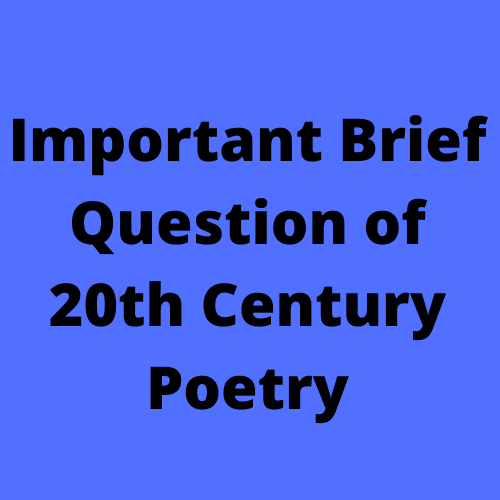Important Brief Question of 20th Century Poetry
W. B. Yeats
1. Why was W. B. Yeats called the National poet of Ireland?
Ans. W. B. Yeats was the poet of the Irish tradition by his birth and temperament, by the accident of his upbringing, and also by deliberate choice that is why he was called the national poet of Ireland.
2. What is I. R. B.?
Ans. The I. R. B. means the secret extremist revolutionary party, Irish Republican Brotherhood. Yeats joined I. R. B. in 1896.
3. When did W. B. Yeats receive the Nobel Prize?
Ans. December 1923
4. What is Innisfree?
Ans. A little island in Lake Lough Gill near the poet’s home in Sligo.
5. How was W. B. Yeats inspired to write The Lake Isle of Innisfree?
Ans. By the sight of a jet of water in a chemist’s shop, while Yeats was standing on an actual London pavement.
6. How will the poet build up a small cabin on the Lake Isle of Innisfree?
Ans. The poet will build up a small cabin or hut with clay and wattles as his habitation on the Lake Isle of Innisfree.
7. How will the poet prepare a garden near his residence on the Innisfree?
Ans. Near his residence on the island of Innisfree, the poet will prepare a vegetable garden where he will have nine bean-rows.
8. Why does the poet propose to have a hive near his dwelling place on the island of Innisfree?
Ans. Because of his romantic temperament.
9. What does the ‘pavements grey’ refer to?
Ans. It means the pathways on the sides of streets for pedestrians, usually made of stones.
10. What is the theme of the poem, The Lake Isle of Innisfree?
Ans. The poet’s longing for escape into an ideal, romantic and dreamy land from the fever and fret of life is the theme of the poem.
11. What is the theme of the poem, Easter 1916?
Ans. The nationalist rising of the Irish people against British rule on the Easter day of 1916.
12. How far was the revolt of 1916 confined?
Ans. The revolt of the Irish patriots on the Easter day of 1916 had been confined to the city of Dublin only.
13. What does the word “motley” refer to?
Ans. The word “motley” stands for a jester or a comedian’s many-colored dress.
14. What does the stone symbolize?
Ans. The stone symbolizes the unity and inflexibility of purpose.
15. What is the meaning of “living stream”?
Ans. The “living stream” means time and action.
16. Who are the symbols of change and flux?
Ans. The horses, the riders, the birds, the clouds, the horse hooves, the hens, and so on.
17. What is the theme of the poem, The Second Coming?
Ans. Disintegration And decay of the present Christian civilization.
18. What does ‘falcon’ symbolize in the poem ‘The Second Coming?
Ans. Falcon is a symbol of mankind or the intellect, science, technology, rationalism, etc.
19. Who is Mac Bride in the poem ‘Easter 1916’?
Ans. John MacBride is the husband of Maud Gonne
20. What is the meaning of the expression, “Turning and turning in the widening gyre”?
Ans. A ‘gyre’ refers to a cone or wheel that spins rapidly around a fixed center. Like the gyre, a civilization expresses initially intense and narrow, and as it progresses, it broadens and slowly loses its intensity and finally disintegrates.
21. What do you mean by the ceremony of innocence”?
Ans. The ceremony of innocence refers to the traditional and innocent way of life which favors and fosters purity and innocence.
22. Why does the ‘Spiritus Mundi’ appear fearful?
Ans. It seems to appear out of some far desert. Because its slow thighs move, birds over the desert see it and begin to scream in fear.
23. What is Bethlehem?
Ans. Bethlehem is the birthplace of Jesus Christ. It is located in Jerusalem.
24. What does the Spiritus Mundi symbolize?
Ans. “The Spiritus Mundi’ is the symbol of the inexorable, pitiless violence, and its birth refers to the death of the present civilization.
25. What Byzantium?
Ans. Byzantium is the capital of the Eastern part of the Roman Empire whose old name is Constantinople.
26. What is a scare-crow?
Ans. A scarecrow is a figure of a man, dressed in old clothes and set up on a stick in the crop fields to scare or frighten the birds from crops.
27. How does the poet visualize the holy saints?
Ans. “standing in God’s holy fire”.
28. What does Innisfree stand for?
Ans, A little island in the Lake Lough Gill near the poet’s home in Sligo.
29. What is ‘terrible beauty”?
Ans. Terrible beauty means the heroic achievement that involved the deaths of many people.
30. Why does the poet want to sail to the holy city of Byzantium?
Ans. Being old and unfit for the world of the senses.
31. Who are the ‘dying generation’?
Ans. The young men and women, all the creatures, fish, flesh or fowl’ in the fullness of their powers, are the ‘dying generation’.
32. In which year did the historical ‘Easter Rising’ take place?
Ans. 1916
33. What do you understand by ‘The Second Coming?
Ans. The Second Coming stands for the coming of a new destructive god and the reversal of Christian values.
32. Who is Maud Gonne?
Ans. Maud Gonne was the beloved of WB Yeats.
